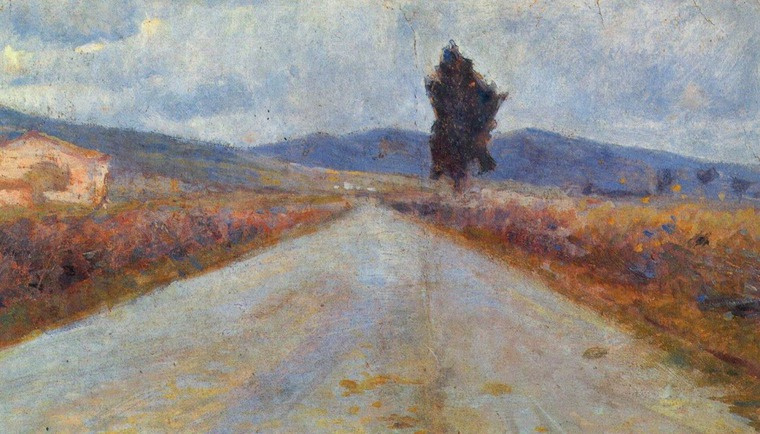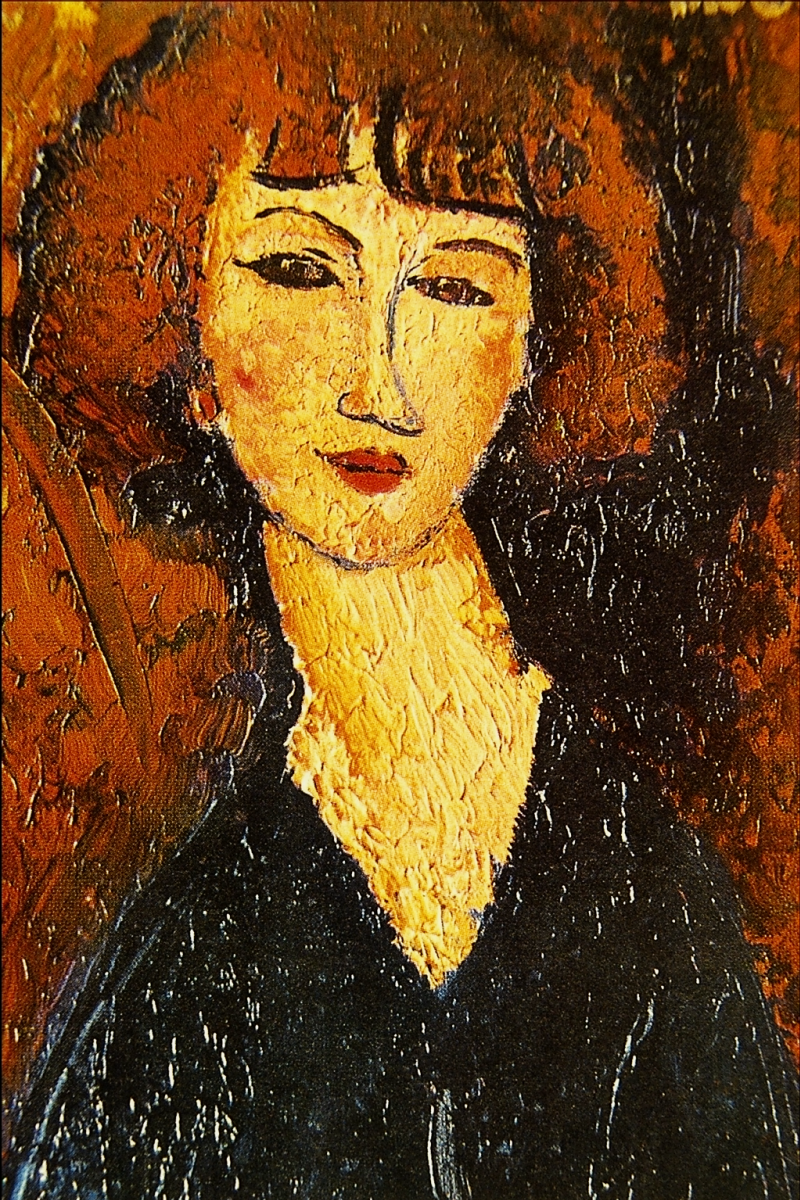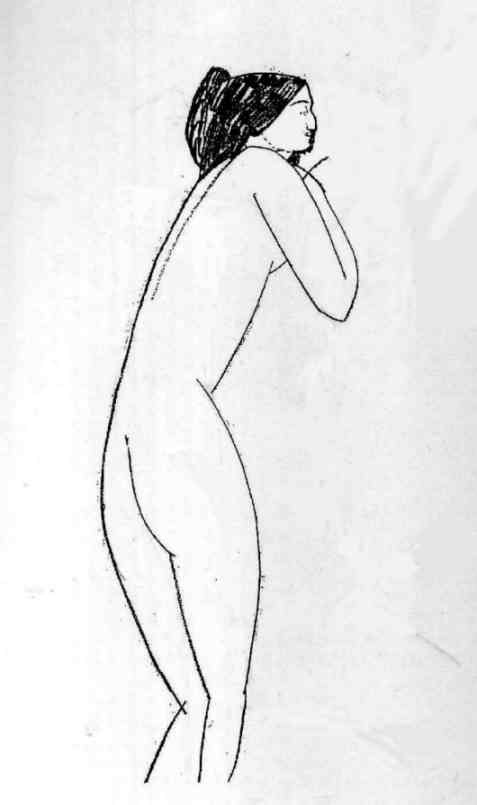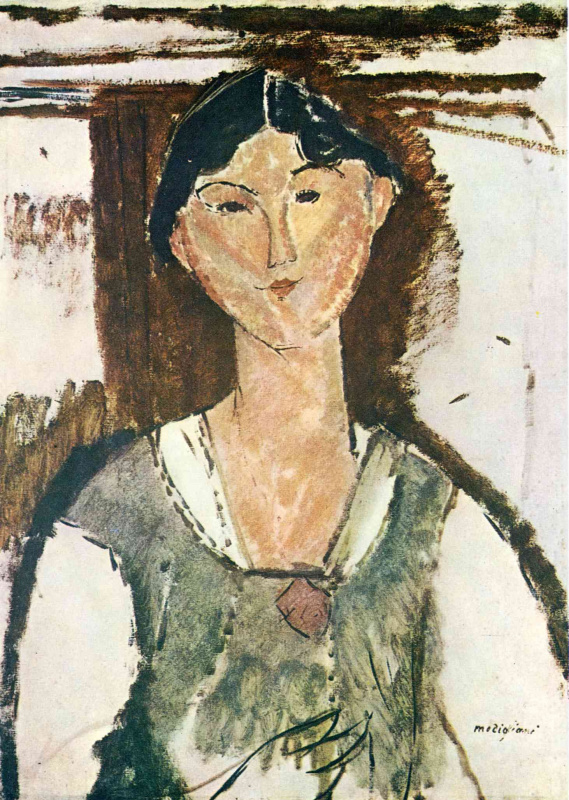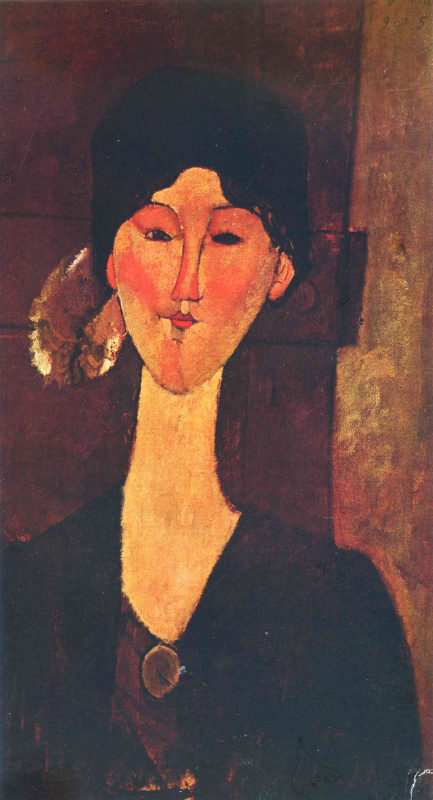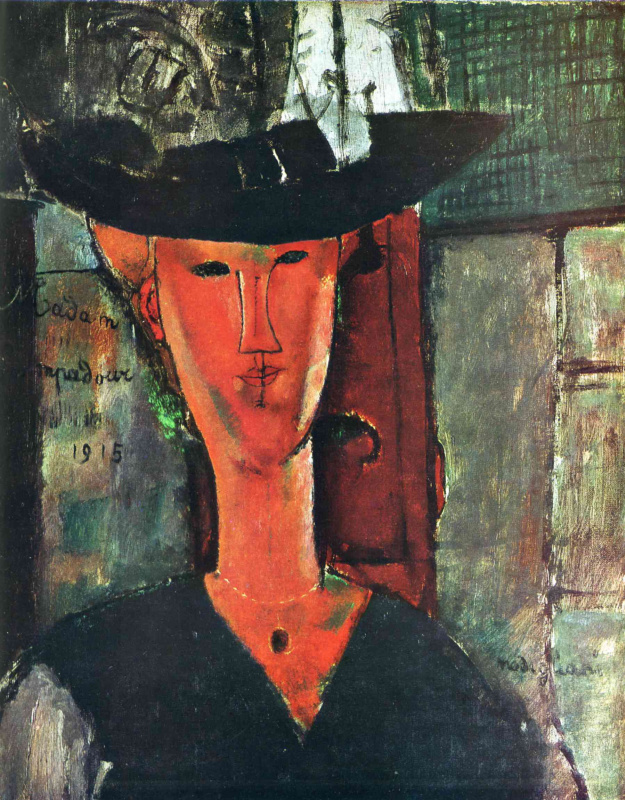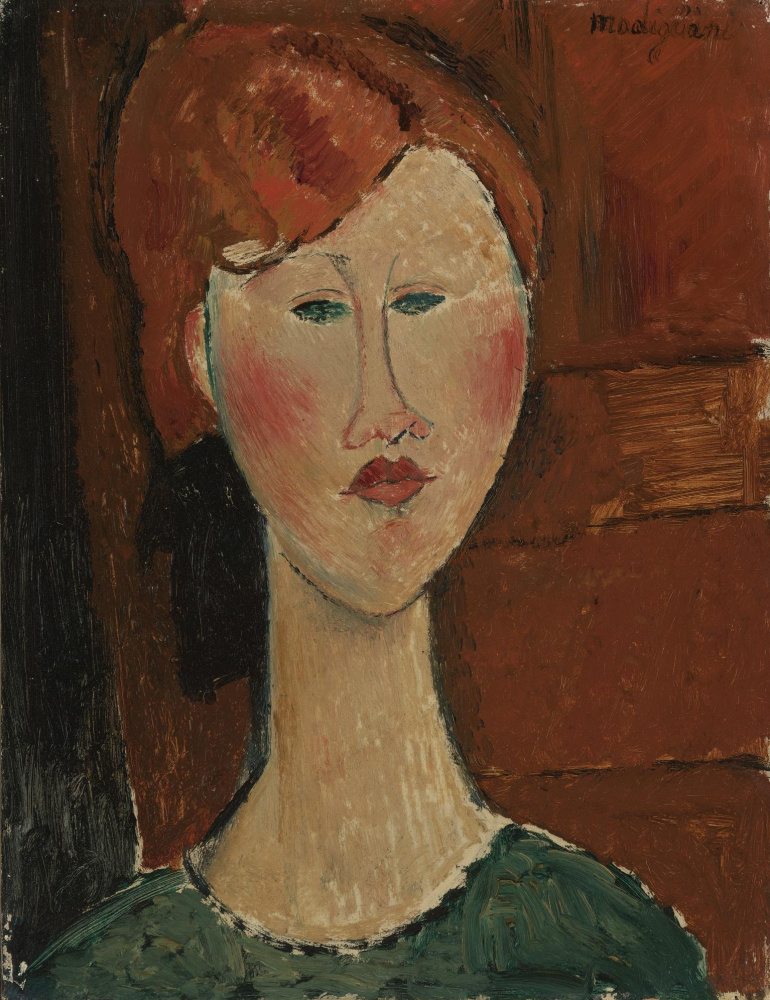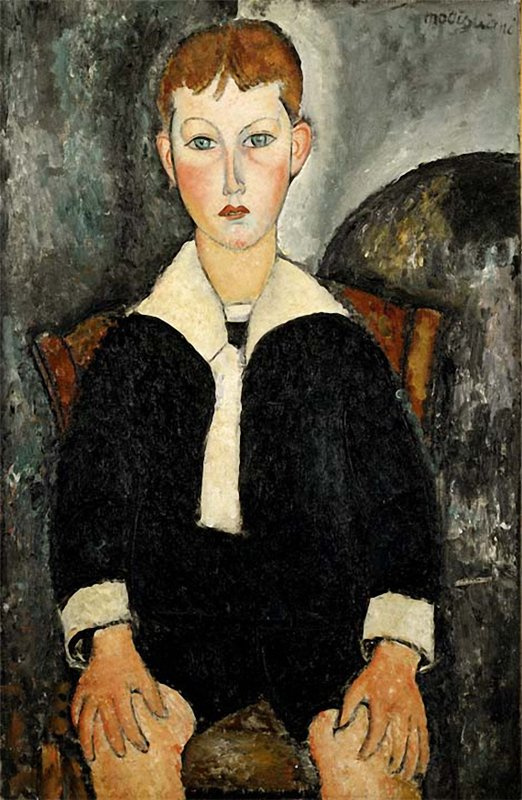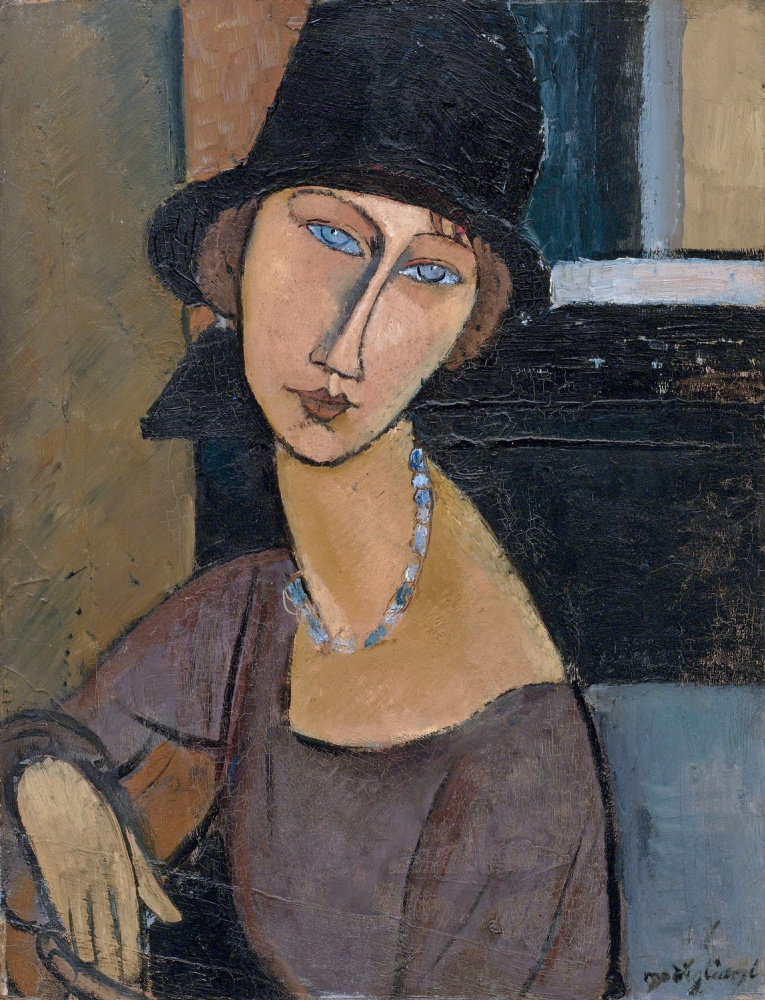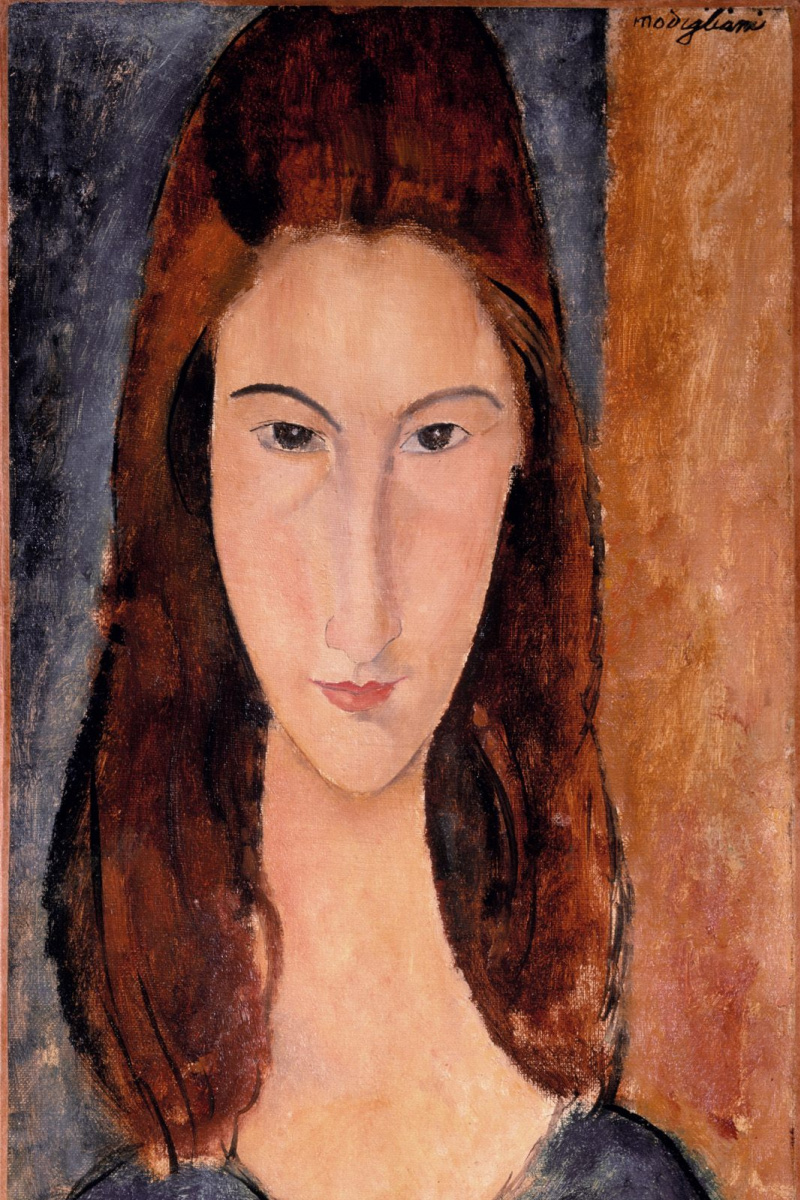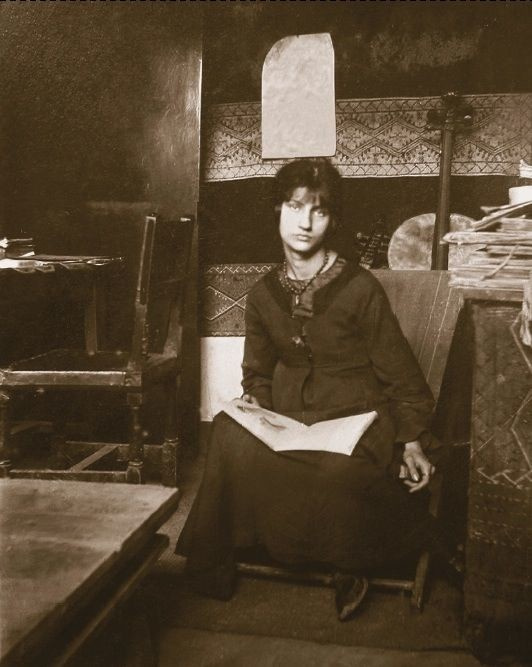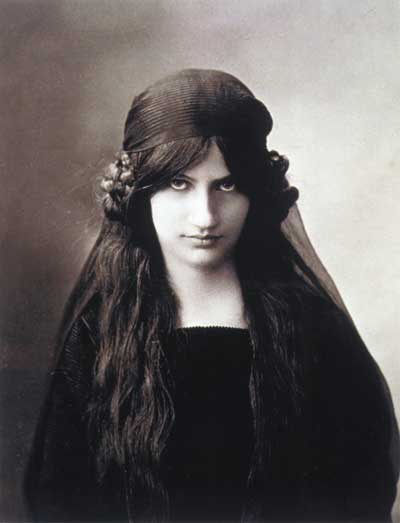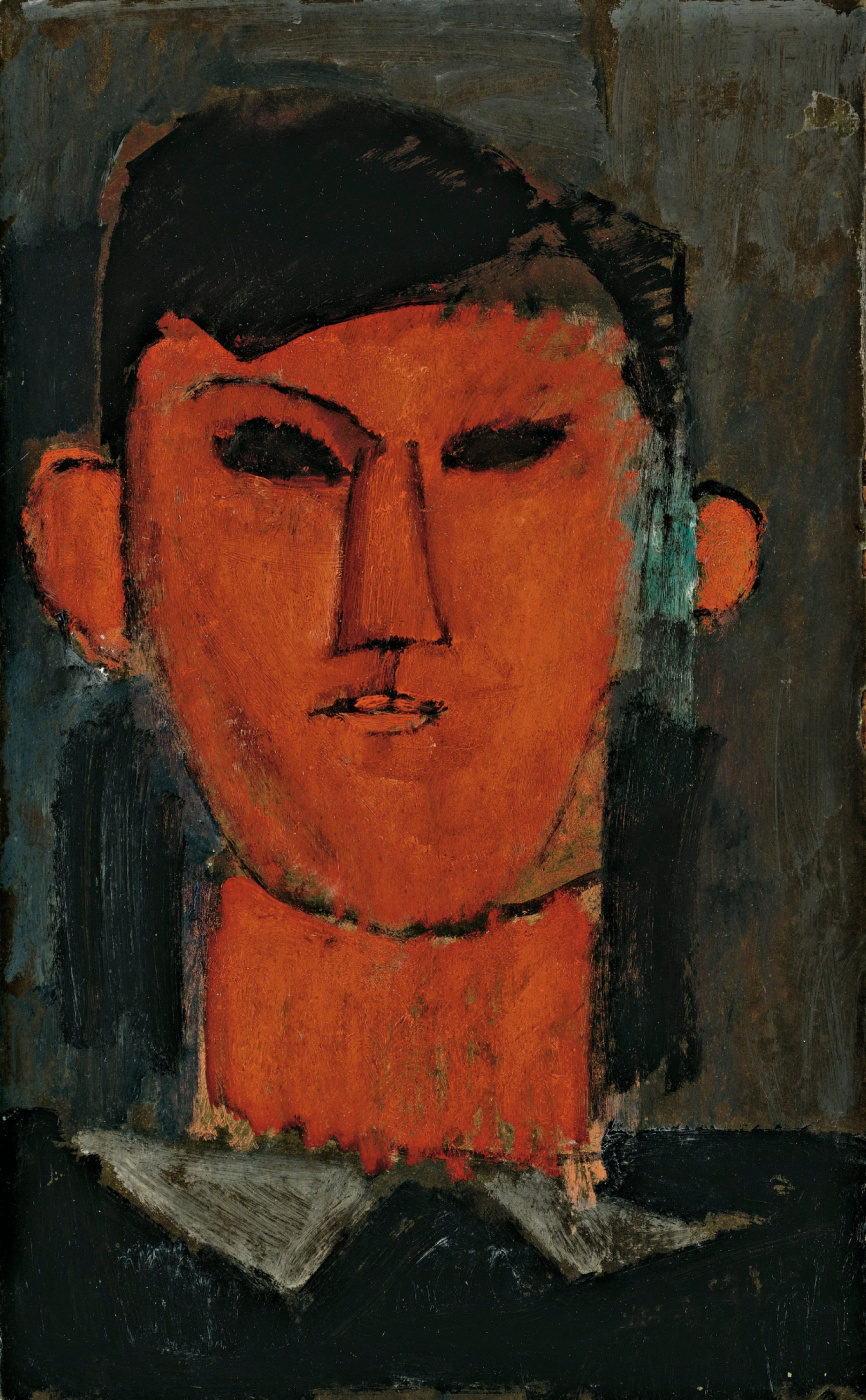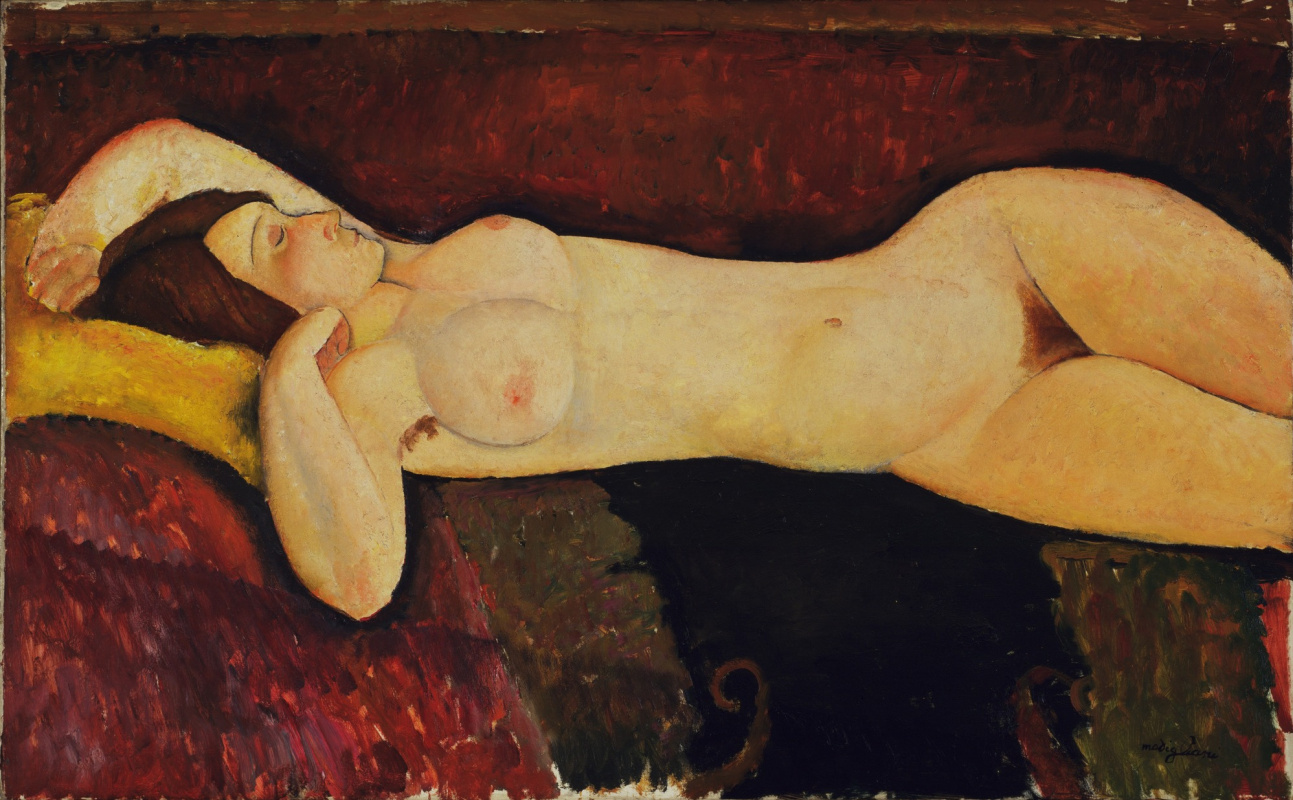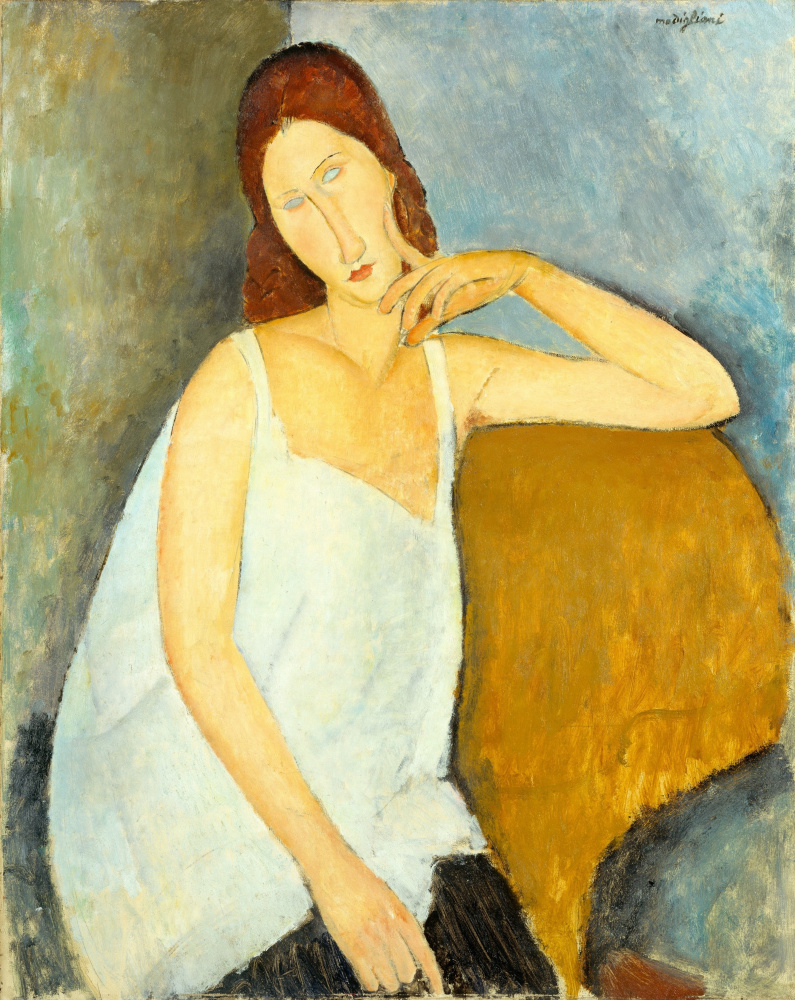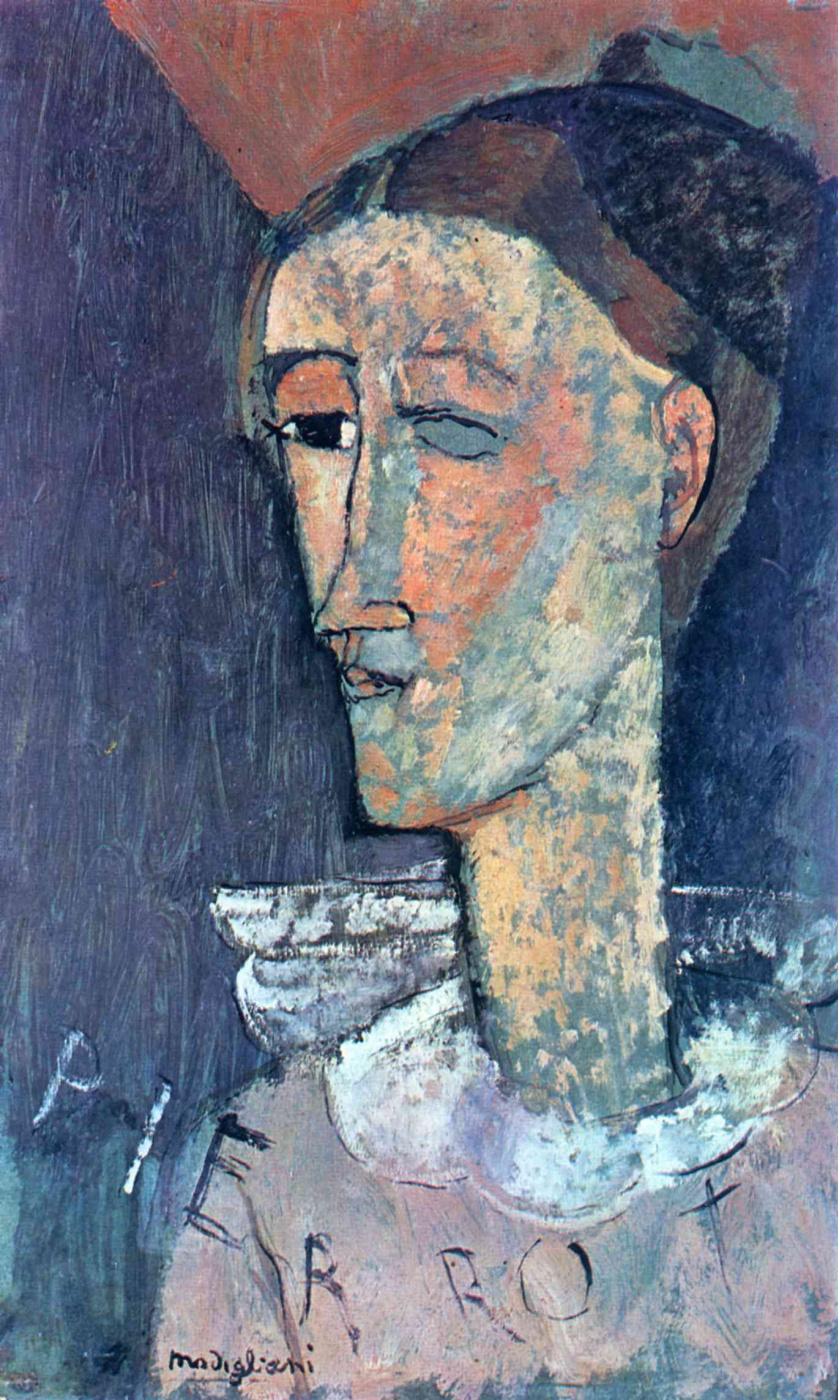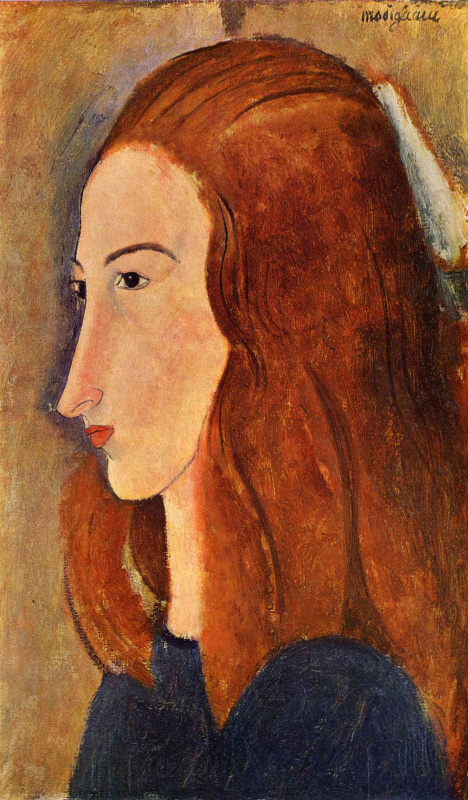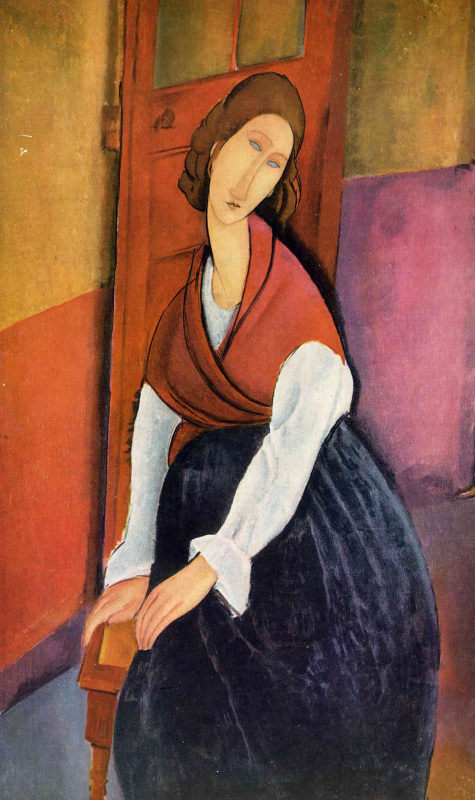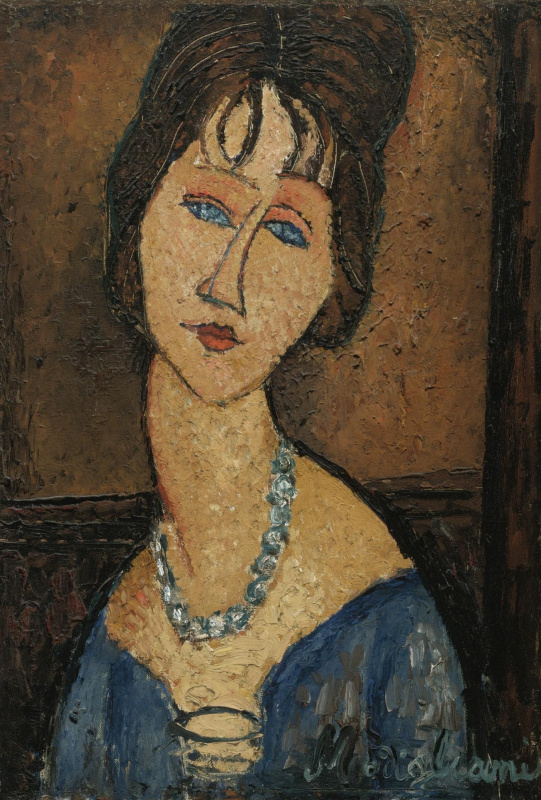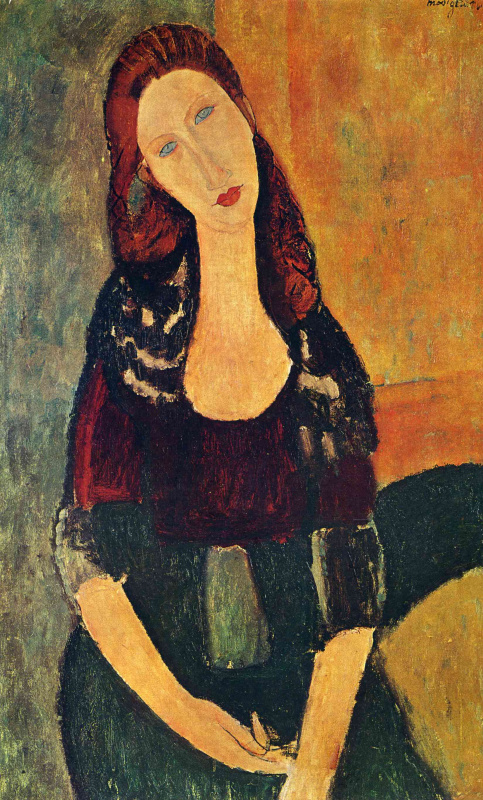They were an eccentric and beautiful couple. He was a temperamental Italian of Jewish origin, an eccentric half-impoverished artist, she was a modest model and an aspiring artist from a respectable Catholic family. Their relationship was completely different from a fairy tale: Amedeo and Jeanne lived together for a very short time, not very happily and died two days apart. After their death, the lovers reunited under a common tombstone, ten years later.
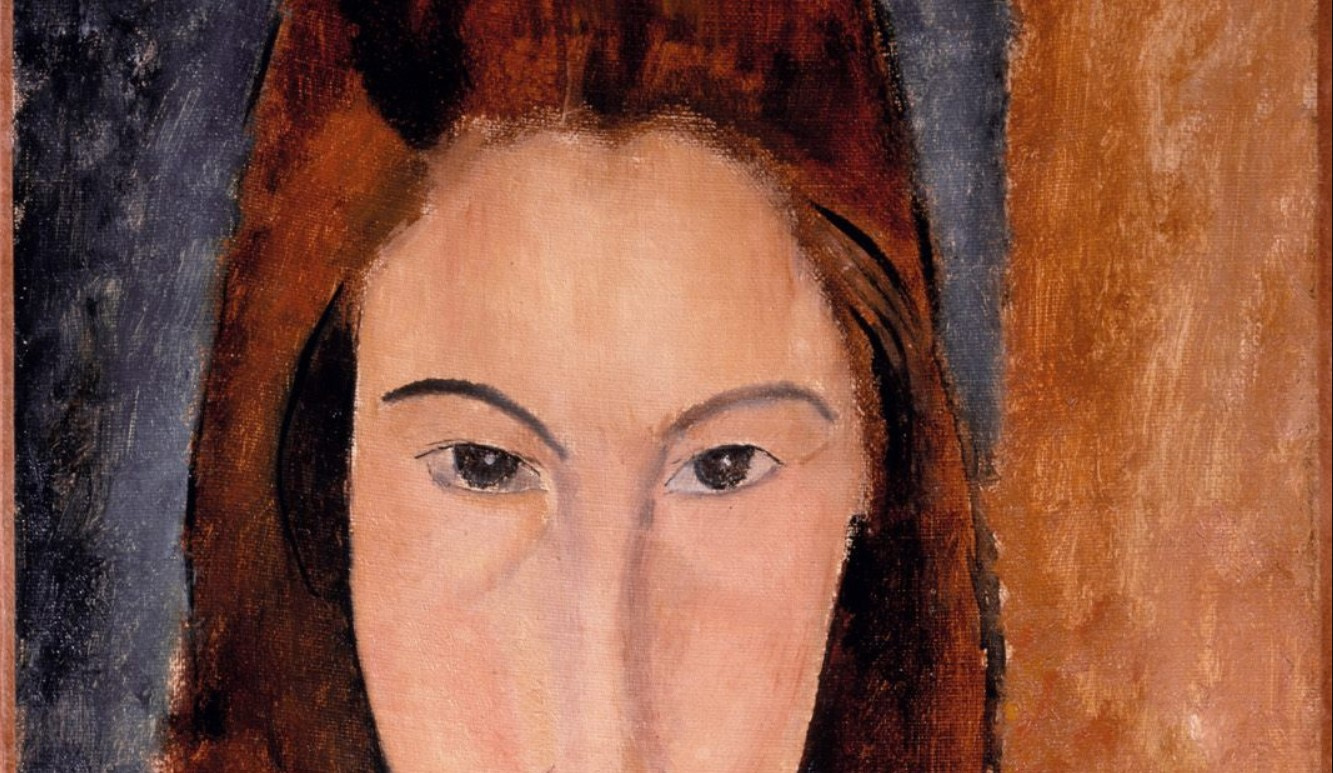
Amedeo. The beginning
Even the birth of the future artist was not trivial. By the time of his birth, his father Flaminio Modigliani, a wood and coal merchant from Livorno, had declared bankruptcy. When his wife Eugenia was about to become a mother for the fourth time, the bailiffs came to arrest the debtor’s property. According to the old Italian law, the bed of a woman in labour was inviolable, so all the valuables in the house that fit on her bed became decorations at the birth of Amedeo.
Tuscan road
1899, 21×36 cm
The boy was quite sickly: first he suffered pleurisy, then typhus, which, according to legend, caused his interest in painting. During attacks of severe fever, he literally raved about the pictures of the Italian classics and spoke of his vocation to create by their example. The parents were so happy about their son’s recovery from a fatal illness that they allowed him to leave school at the age of 14 and enter the Guglielmo Micheli private art studio, where Modigliani became the youngest student.
Italian woman
1917, 102.6×67 cm
Two years later, it became known about his tuberculosis, which tortured him for the rest of his life. Despite poor health, he entered the Free School of Nude Painting in Florence, and some time later went to Venice to study at the Institute of Fine Arts. And in 1906, Modigliani moved to Paris to plunge headlong into the abyss of the bohemian life that many progressive artists of that time led in the French capital.

Regulars of the entrance to the Rotunda café. From left to right: Modigliani, Picasso, poet André Salmon. 1915
Photo Source: a-modigliani.ru
Photo Source: a-modigliani.ru
The metropolitan way of life absorbed Amedeo in earnest: alcohol and hashish became his constant companions. They helped to distract from poverty and the feeling of unfulfilment, which the artist felt permanently: no one liked his paintings, he scarcely sold them, and he did not have enough health or funds for his passion for sculpture. However, the catchy appearance and good manners made Modigliani attractive in the eyes of women. He was credited with several bright affairs with outstanding and very dissimilar women — these affairs flared up as quickly as they went out.
A young woman from Montparnasse
1915, 65×45 cm
In a whirlpool of passion
The artist was rumoured to have a love relationship with Anna Akhmatova. They met when he was 26, she was only 20, and she arrived in Paris in 1910 on her honeymoon with her husband Nikolai Gumilyov. According to a legend, upon the return of the poetess to Petersburg, Modigliani wrote her passionate letters. When Akhmatova was in Paris again, they spent three months together, after which she returned to her husband.However, there is no evidence of their relationship. Indirect evidence is considered a drawing by Modigliani depicting Akhmatova and her essay on their communication, written half a century later. It said that their relationship was purely friendly. They walked a lot along the streets of the French capital and recited poems of their favourite poets on a bench in the Luxembourg Park. According to Anna, the pencil sketch
, presented by the artist to Anna, was drawn by Modigliani from memory, and she did not pose for him in the nude
at all.
Woman lying on the bed (Anna Akhmatova)
1911, 26.5×43 cm
Akhmatova said that Modigliani was always surrounded by a dense circle of loneliness, even when he was in a crowd that warmly greeted him. "Probably, we both did not understand one essential thing: everything that happened was the background of our lives: his very short, and my very long life," she wrote.
In 1915, Modigliani met with a woman as eccentric as himself. Beatrice Hastings (real name Emily Alice Hay) was a British poet and writer with a passion for theosophy and mysticism. She settled in Montmartre near Modigliani’s studio, and soon walked the streets of Paris, attracting the glances of passers-by. Beatrice, although she dressed elegantly and restrained as an English, was in the habit of adding a bright detail to her costume, such as a fancy hat or a basket with a live duck in her hand. The outfit of her gentleman was painted rags, which were once a sturdy velvet suit.
In 1915, Modigliani met with a woman as eccentric as himself. Beatrice Hastings (real name Emily Alice Hay) was a British poet and writer with a passion for theosophy and mysticism. She settled in Montmartre near Modigliani’s studio, and soon walked the streets of Paris, attracting the glances of passers-by. Beatrice, although she dressed elegantly and restrained as an English, was in the habit of adding a bright detail to her costume, such as a fancy hat or a basket with a live duck in her hand. The outfit of her gentleman was painted rags, which were once a sturdy velvet suit.
Amazon. Portrait Of Beatrice Hastings
1909, 92×65 cm
The couple was famous not only for their remarkable appearance — the shocking was the hallmark of their relationship. Beatrice wasn’t second to the artist in terms of both drinking and temperamental antics.
She left written evidence of this: "Dedo usually came drunk and broke the windows trying to enter the house. If I myself was drunk at the same time, a terrible scene began," Beatrice recalled in her notes. "Once we had a large battle, we chased each other around the house, up and down the stairs, while his weapon was a flower pot, and mine was a long broom. He then smashed the outer shutters, which immediately interested the landlord, who had been guarding his property for several nights in a row and now decided to ensure my peace. I was so happy then, in this Montmartre hut!"
She left written evidence of this: "Dedo usually came drunk and broke the windows trying to enter the house. If I myself was drunk at the same time, a terrible scene began," Beatrice recalled in her notes. "Once we had a large battle, we chased each other around the house, up and down the stairs, while his weapon was a flower pot, and mine was a long broom. He then smashed the outer shutters, which immediately interested the landlord, who had been guarding his property for several nights in a row and now decided to ensure my peace. I was so happy then, in this Montmartre hut!"
Surprisingly, this peculiar relationship lasted almost two years. During this time, Modigliani painted many portraits of his beloved, although it is difficult to suspect the artist of love for his model based on them. He portrayed her as a not very attractive woman with evil eyes and primly pursed lips, although in the surviving photographs, Beatrice looks more than pretty.

Beatrice Hastings in Paris, 1918.
Photo Source: tate.org.uk
Photo Source: tate.org.uk
Amedeo’s next documented passion was Simone Thiroux, a student from Canada who worked as a model for artists. They met in a dairy shop, where he paid for her purchases with his drawing. Simone began to pose for him, and then moved to the artist completely.

Amedeo Modigliani. Photo Source
In Modigliani, there was something that made women lose their heads and write to him such lines asking for reconciliation after parting: "I swear by the head of my son, who is everything for me, that I am far from any cunning. But I loved you too much, and I suffer so much that I beg you for this, as for the last mercy… I just would like to feel a little less hatred from you. I beg you, consider me kindly. Console me at least a little, I am too unhappy, and I only need a bit of affection that would help me so much."
Portrait of a woman with red hair
1917, 35×27 cm
The child Simone mentions in the letter may have been Modigliani’s son, although he vehemently denied this. When she died of tuberculosis just a year after the artist’s death, the boy was given up for adoption. The woman who helped find the foster family received a photo of a child strikingly similar to Modigliani a few years later, but the photo had no signatures on it. The recognized daughter of the artist, Jeanne Modigliani, considered the Simone Thiroux’s child the son of the artist, which she mentioned in her Modigliani: Man and Myth book.
Portrait of a seated boy in a sailor suit
1917, 92.1×60.3 cm
Also read
10 facts about Amedeo Modigliani
Jeanne forever
In the summer of 1917, 33-year-old Amedeo met 19-year-old Jeanne Hébuterne, a young Parisian woman who would become his devoted companion for the rest of his life. Most likely, they met at the Accademia Colarossi, where she worked over her easel, over and over again erasing the drawing to start over. The girl aspired to become an artist like her older brother André, whose landscapes had already been exhibited in the Salon d’Automne. According to some reports, Jeanne was also a model for Tsuguharo Fujita, an avant-garde artist of Japanese origin who arrived to conquer Paris in 1913.The daughter, Jeanne Modigliani, described her mother in the words of her acquaintances: "Jeanne was small in stature, with reddish brown hair and very white skin. Because of this vivid contrast between hair and face, her friends called her Coconut."
Portrait of Jeanne hebuterne in a hat
1917, 67×51.5 cm
Jeanne’s father, Achille Casimir Hébuterne, was an perfume company employee and a diligent Catholic, in the evenings he made his whole family listen to selected passages from the works of his beloved philosopher Pascal. Despite the fact that Jeanne complained to her friend about the regular executions with philosophical thought, this family tradition had a significant impact on the formation of her personality. Acquaintances described her as a sane and serious person with a pronounced personality.
Poet Mark Talov recalled: "She looked like a bird easy to scare away. Feminine with a shy smile. She spoke very softly. Never had a sip of wine. She looked at everyone as if surprised."
Poet Mark Talov recalled: "She looked like a bird easy to scare away. Feminine with a shy smile. She spoke very softly. Never had a sip of wine. She looked at everyone as if surprised."
Portrait Of Jeanne Hebuterne
1919, 55×38 cm
For all her outward modesty and restraint, Jeanne had a strong will. When she told her parents about the seriousness of her intention to link her life with Modigliani, they definitely opposed her intention. Not only was the artist famous for his drunken adventures and living on the brink of poverty, he was also a Jew, which at that time was absolutely unacceptable for Catholics.
Jeanne preferred her beloved to her parents, which meant an actual break with them. And although the artist did not manage to legalize his relationship with his beloved, for those around him — friends, Amedeo’s mother and the whole bohemian crowd — she immediately was considered his wife. And even her parents, over time, were forced to admit this uncomfortable choice of their obstinate daughter.
Portrait of Jeanne hebuterne (with a scarf)
1919, 92×54 cm
Before meeting Jeanne, Modigliani lived at the Hotel de Min for some time, where his room was paid for by the philanthropist Leopold Zborovsky. But there was very little space in it for the couple, and he found another place for them with extremely modest conditions, but with more spacious room on the penultimate floor of an old house with large windows blown by the wind. Zborovsky’s wife and her friend put things in order and furnished the apartment on their own, delivered a stove and some pieces of furniture there. Modigliani set about covering up the countless cracks through which the sun shone into the room, and painted the walls orange and ocher.

Jeanne Hébuterne. Self-portrait, 1916.
Now the lovers lived near the Luxembourg Gardens. They had only two rooms at their disposal, in which there was not even a sofa: the artist offered the guests to use a suitcase instead of a sofa. He eventually had sell even the suitcase, because the couple did not always have money even for lunch in the absence of those who wanted to buy his paintings. But Jeanne never complained about the poor atmosphere and life from hand to mouth — she felt it like a real paradise, even when her beloved did not stop spending his rare and casual earnings on alcohol and hashish.
Self-portrait
1919, 100×64.5 cm
Of course, those around were perplexed: what could such a beautiful girl from a good family find in an artist exhausted by tuberculosis, drunkenness and poverty? Well, except for what we call charisma today, Modigliani had good manners and a kind soul. This is what remained unchanged, regardless of Amedeo’s lifestyle. Those who knew him closely enough spoke of the artist as a sympathetic, devoted and decent friend, and even believed that his intemperance and eccentric antics in drinkeries were ostentatious. Picasso is credited with the following words: "It's strange, you never see Modigliani drunk somewhere on the Boulevard Saint-Denis, but you always do on the corner of Boulevard Montparnasse and Boulevard Raspail."
Portrait Of Pablo Picasso
1915, 43.2×26.7 cm
The beginning of the end
With the advent of 1918, it became clear that tuberculosis began to take away the artist’s strength: he lost a lot of weight and coughed incessantly at night. Jeanne became pregnant and also complained of poor health. The poet and collector Leopold Zborowski, who financially supported Modigliani and sold his paintings, decided to pay for their residence in the south of France so that the couple could improve their health.
Portrait Of Leopold Zborowski
1918, 100×64 cm
It was thanks to the Zborovsky’s active assistance that a series of paintings with nude
models was born, which later became the most famous works by Modigliani.
The collector set a daily wage of 15 to 20 francs, supplied the artist with the necessary consumables, hired models and even provided his own apartment as a studio. Zborovsky was ready to do literally anything to support the talent in which he believed unconditionally. He liked to repeat: "Amedeo is a great artist. I wish I had enough money for him to draw and not sell his drawings in a café."
The collector set a daily wage of 15 to 20 francs, supplied the artist with the necessary consumables, hired models and even provided his own apartment as a studio. Zborovsky was ready to do literally anything to support the talent in which he believed unconditionally. He liked to repeat: "Amedeo is a great artist. I wish I had enough money for him to draw and not sell his drawings in a café."
Her mother went to Nice with Jeanne and Amedeo to support her daughter during her pregnancy. For a while, these three lived together, but the situation quickly heated up and Modigliani hastily moved to a cheap hotel. There prostitutes agreed to pose for the artist out of sympathy, free of charge, seeing his plight — even the objections of the pimps could not stop them. In Nice, he wrote as many as nine letters to Zborovsky: with requests to send money, with gratitude for financial support. In them, the artist expressed concern that he became too much of a burden for his patron. And although Amedeo tried to paint a certain number of paintings every month, he had an extremely difficult time. Not only did he barely have enough strength to work, the too bright sun and a change in the usual environment with the defiantly luxurious atmosphere of the fashionable resort did little to help painting.
Landscape. South France
1919, 60×45 cm
On 29 November 1918, Jeanne gave birth to a daughter, who was named after her mother. She couldn’t feed the child, she had to resort to the help of a wet nurse, which became an additional item of expenses. Modigliani still continued to drink, which made his health deteriorate even more. Jeanne had a very difficult time with her newborn baby, but she never complained or reproached Amedeo. He behaved like a real Italian in relation to his family: he only introduced Jeanne to his closest friends and never appeared with her in public. As Jeanne Modigliani later suggested in her book on her father, he was apparently very proud of his wife and newborn daughter, but at the same time, responsibility could instil fear in him.
Portrait of Jeanne hebuterne, left hand combing flowing hair
1919, 100.3×65.4 cm
In the early summer of 1919, Modigliani returned to Paris with Jeanne and her daughter. The child had to be sent to the village to her nurse, since there were no conditions for caring for the baby in the studio where they lived. Jeanne visited her weekly, but she could not leave Modigliani alone in Paris. She became pregnant again, and the artist seriously set out to legitimize their relationship: he even signed a corresponding statement. But he could not carry out his intention.
Portrait Of Jeanne Hebuterne
1919, 91.4×73 cm
By winter, he was getting worse, and either from deteriorating health, or from progressive drunkenness, the artist got evil even against Jeanne. He increasingly disappeared in drinking establishments, and she looked for him there trying to take him home and save him from trouble. But one day she failed.
On a frosty day in mid-January 1920, after a drinking bout, Modigliani did not reach the studio, and after a night on the street, he fell ill with jade. His condition deteriorated rapidly over the course of several days. The artist was taken to the hospital, where on 24 January he died of tuberculous meningitis.
On a frosty day in mid-January 1920, after a drinking bout, Modigliani did not reach the studio, and after a night on the street, he fell ill with jade. His condition deteriorated rapidly over the course of several days. The artist was taken to the hospital, where on 24 January he died of tuberculous meningitis.
Self-portrait in a Pierrot
1915, 43×27 cm
No life without love
On the morning of 25 January, Jeanne went to the hospital to see her deceased lover for the last time. She stood at the body of Modigliani for a long time in complete silence and then she walked away from him, without taking her eyes off him. Her father persuaded her to go to her parents' house afterwards, where they could look after her. There, Jeanne kept being silent, without shedding a single tear. Throughout the night, her brother André visited her room and found Jeanne standing thoughtful by the window each time. At 4 o’clock in the morning, she threw herself out of this window — the window of the fifth floor, taking the life of her and Amedeo’s second child who was about to be born with her.
Jeanne Hébuterne. Portrait of Modigliani, 1919
Modigliani was buried on 27 January at the Jewish site of the Père Lachaise Cemetery in front of a large crowd of people: his friends, artists and ordinary Parisian citizens. As it happens to this day, the death of the artist aroused increased both interest in his work and the demand for his paintings: cunning businessmen tried to buy his work for next to nothing, before the price began to rise.

Jeanne Hébuterne. Death, 1919
Jeanne’s funeral took place the next day in almost complete secrecy: in the remote Banier cemetery, in the presence of only the closest relatives. Her family blamed Modigliani for the death of their daughter and were opposed to Amedeo and Jeanne being buried next to each other. But 10 years later, at the insistence of the artist’s relatives, the remains of Jeanne Hébuterne were nevertheless transported to the Père Lachaise Cemetery and reburied next to her lover.
Also read
Modigliani: see Paris and die
The tragic love story that only lasted two and a half years, left a noticeable mark in art through several dozen paintings by Modigliani depicting Jeanne Hébuterne. And in 2004, director Mick Davis shot the Modigliani feature film starring Andy Garcia.

Jeanne Modigliani. Photo Source






